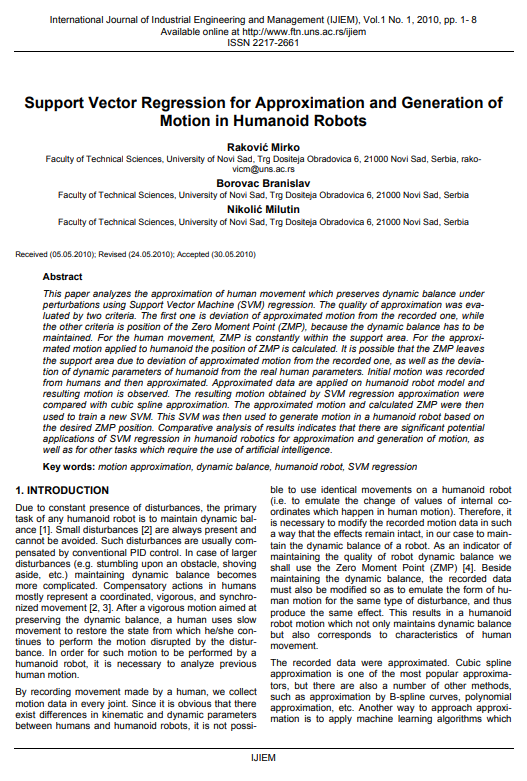Support Vector Regression for Approximation and Generation of Motion in Humanoid Robots

Published 2010-03-30
abstract views: 23 // FULL TEXT ARTICLE (PDF): 0
Keywords
- motion approximation,
- dynamic balance,
- humanoid robot,
- SVM regression
How to Cite
Copyright (c) 2023 International Journal of Industrial Engineering and Management

This work is licensed under a Creative Commons Attribution 4.0 International License.
Abstract
This paper analyzes the approximation of human movement which preserves dynamic balance under perturbations using Support Vector Machine (SVM) regression. The quality of approximation was eva-luated by two criteria. The first one is deviation of approximated motion from the recorded one, while the other criteria is position of the Zero Moment Point (ZMP), because the dynamic balance has to be maintained. For the human movement, ZMP is constantly within the support area. For the approxi-mated motion applied to humanoid the position of ZMP is calculated. It is possible that the ZMP leaves the support area due to deviation of approximated motion from the recorded one, as well as the devia-tion of dynamic parameters of humanoid from the real human parameters. Initial motion was recorded from humans and then approximated. Approximated data are applied on humanoid robot model and resulting motion is observed. The resulting motion obtained by SVM regression approximation were compared with cubic spline approximation. The approximated motion and calculated ZMP were then used to train a new SVM. This SVM was then used to generate motion in a humanoid robot based on the desired ZMP position. Comparative analysis of results indicates that there are significant potential applications of SVM regression in humanoid robotics for approximation and generation of motion, as well as for other tasks which require the use of artificial intelligence.
Article history: Received (05.05.2010); Revised (24.05.2010); Accepted (30.05.2010)

